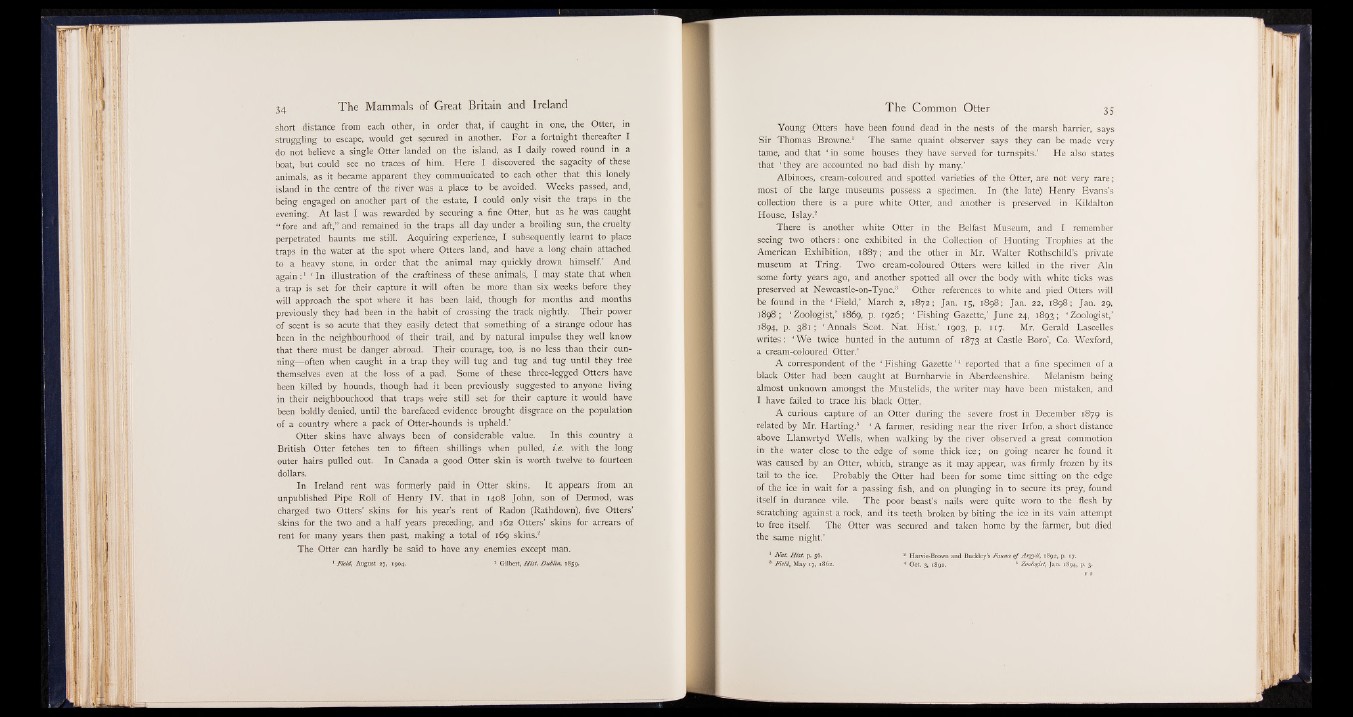
short distance from each other, in order that, if caught in one, the Otter, in
struggling to escape, would get secured in another. For a fortnight thereafter I
do not believe a single Otter landed on the island, as I daily rowed round in a
boat, but could see no traces of him. Here I discovered the sagacity of these
animals, as it became apparent they communicated to each other that this lonely
island in the centre of the river was a place to be avoided. Weeks passed, and,
being engaged on another part of the estate, I could only visit the traps in the
evening. At last I was rewarded by securing a fine Otter, but as he was caught
“ fore and aft,” and remained in the traps all day under a broiling sun, the cruelty
perpetrated haunts me still. Acquiring experience, I subsequently learnt to place
traps in the water at the spot where Otters land, and have a long chain attached
to a heavy stone, in order, that the animal may quickly drown himself.’ And
again: 1 * In illustration of the craftiness of these animals, I may state that when
a trap is set for their capture it will often be more than six weeks before they
will approach the spot where it has been laid, though for months and months
previously they had been in the habit of crossing the track nightly. Their power
of scent is so acute that they easily detect that something of a strange odour has
been in the neighbourhood of their trail, and by natural impulse they well know
that there must be danger abroad. Their courage, too, is no less than their cunning—
often when caught in a trap they will tug and tug and tug until they free
themselves even at the loss of a pad. Some of these three-legged Otters have
been killed by hounds, though had it been previously suggested to anyone living
in their neighbourhood that traps were still set for their capture it would have
been boldly denied, until the barefaced evidence brought disgrace on the population
of a country where a pack of Otter-hounds is upheld.’
Otter skins have always been of considerable value. In this country a
British Otter fetches ten to fifteen shillings when pulled, i.e. with the long
outer hairs pulled out. In Canada a good Otter skin is worth twelve to fourteen
dollars.
In Ireland rent was formerly paid in Otter skins. It appears from an
unpublished Pipe Roll of Henry IV. that in 1408 John, son of Dermod, was
charged two Otters’ skins for his year’s rent of Radon (Rathdown), five Otters’
skins for the two and a half years preceding, and 162 Otters’ skins for arrears of
rent for many years then past, making a total of 169 skins.2
The Otter can hardly be said to have any enemies except man.
Field, August 27, 1904. 2 Gilbert, Hist, Dublin, 1859.
Young Otters have been found dead in the nests of the marsh harrier, says
Sir Thomas Browne.1 The same quaint observer says they can be made very
tame, and that ‘ in some houses they have served for turnspits.’ He also states
that ‘ they are accounted no bad dish by many.’
Albinoes, cream-coloured and spotted varieties of the Otter, are not very rare;
most of the large museums possess a specimen. In (the late) Henry Evans’s
collection there is a pure white Otter, and another is preserved in Kildalton
House, Islay.2
There is another white Otter in the Belfast Museum, and I remember
seeing two others: one exhibited in the Collection of Hunting Trophies at the
American Exhibition, 1887; and the other in Mr. Walter Rothschild’s private
museum at Tring. Two cream-coloured Otters were killed in the river Ain
some forty years ago, and another spotted all over the body with white ticks was
preserved at Newcastle-on-Tyne.8 Other references to white and pied Otters will
be found in the ‘ Field,’ March 2, 1872; Jan. 15, 1898; Jan. 22, 1898; Jan. 29,
1898; ‘ Zoologist,’ 1869, p. 1926; ‘ Fishing Gazette,’ June 24, 1893; ‘ Zoologist,’
1894, p. 3 8 1 ; ‘ Annals Scot. Nat. Hist.’ 1903, p. 117 . Mr. Gerald Lascelles
writes: ‘We twice hunted in the autumn of 1873 at Castle Boro’, Co. Wexford,
a cream-coloured Otter.’
A correspondent of the ‘ Fishing Gazette ’ 1 reported that a fine specimen of a
black Otter had been caught at Burnharvie in Aberdeenshire. Melanism being
almost unknown amongst the Mustelids, the writer may have been mistaken, and
I have failed to trace his black Otter.
A curious capture of an Otter during the severe frost in December 1879 is
related by Mr. Harting.5 ‘ A farmer, residing near the river Irfon, a short distance
above Llanwrtyd Wells, when walking by the river observed a great commotion
in the water close to the edge of some thick ice; on going nearer he found it
was caused by an Otter, which, strange as it may appear, was firmly frozen by its
tail to the ice. Probably the Otter had been for some time sitting on the edge
of the ice in wait for a passing fish, and on plunging in to secure its prey, found
itself in durance vile. The poor beast’s nails were quite worn to the flesh by
scratching against a rock, and its teeth broken by biting the ice in its vain attempt
to free itself. The Otter was secured and taken home by the farmer, but died
the same night.’
1 Nat. Hist. p. 56.
3 Field, May 17, 1862.
2 Harvie-Brown and Buckley’s Fauna o f Argyll, 1892, p. 17.
* Oct. 3, 1891. 6 Zoologist, Jan. 1894, p. 3.